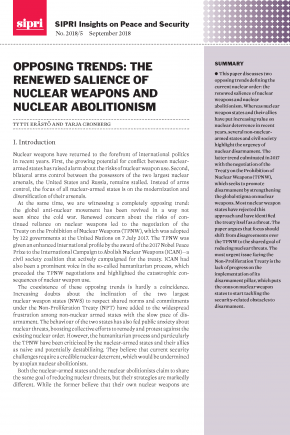Opposing Trends: The Renewed Salience of Nuclear Weapons and Nuclear Abolitionism
This paper discusses two opposing trends defining the current nuclear order: the renewed salience of nuclear weapons and nuclear abolitionism. Whereas nuclear weapon states and their allies have put increasing value on nuclear deterrence in recent years, several non-nuclear-armed states and civil society highlight the urgency of nuclear disarmament. The latter trend culminated in 2017 with the negotiation of the Treaty on the Prohibition of Nuclear Weapons (TPNW), which seeks to promote disarmament by strengthening the global stigma on nuclear weapons.
Most nuclear weapon states have rejected this approach and have identified the treaty itself as a threat. This paper argues that focus should shift from disagreements over the TPNW to the shared goal of reducing nuclear threats. The most urgent issue facing the Non-Proliferation Treaty (NPT) is the lack of progress on the implementation of its disarmament pillar, which puts the onus on nuclear weapon states to start tackling the security-related obstacles to disarmament.
I. Introduction
II. Legitimacy crisis of the NPT
III. Increased salience of nuclear threats
IV. The revival of nuclear abolitionism
V. Obstacles to disarmament: Security and status concerns
VI. Future prospects


